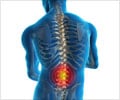Stepladder injuries, brought about by a fall, are very common. And now a study has explored how improved design and user behavior can decrease the likelihood of future accidents.

Compared with a flat surface, stepladders present a smaller and less rigid surface on which to stand, and the narrow steps make it easier for a person to lose his or her balance.
While standing on a stepladder, users may not be able to take a step to regain their balance or grab something to steady them, particularly while holding tools or other objects.
"In order to most effectively improve the safety of ladders, the causation of accident needs to be analyzed and better understood," explained Baker.
"In many of the cases we have investigated, the claimed cause of ladder accidents is that the person 'just lost their balance,' or 'just fell'.
"This raises several questions, including what factors cause someone to lose his or her balance in general, how a fall from a ladder can be precipitated by disturbances that would not lead to a fall for a person standing on the ground, and how ladders can be designed and used to minimize the risk of a fall," he stated.
Advertisement
For example, the ladder could be more rigid to provide a stable work platform, which could offset human balance problems.
Advertisement
Users should be warned to avoid excessively reaching or looking above their heads while standing on a too-small stepladder, as this can cause them to sway and lose their balance.
Choice of footwear also makes a difference; shoes with thin, hard soles can improve balance and stability.
Source-ANI









